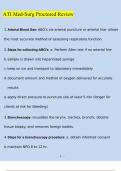Samenvatting
Summary Neurophysiology part of course From Molecule to Mind Neurosciences master VU
- Instelling
- Vrije Universiteit Amsterdam (VU)
This is a summary of the lectures of the Neurophysiology part of the course from Molecule to Mind in the master Neurosciences (or Biomedical Sciences).
[Meer zien]













